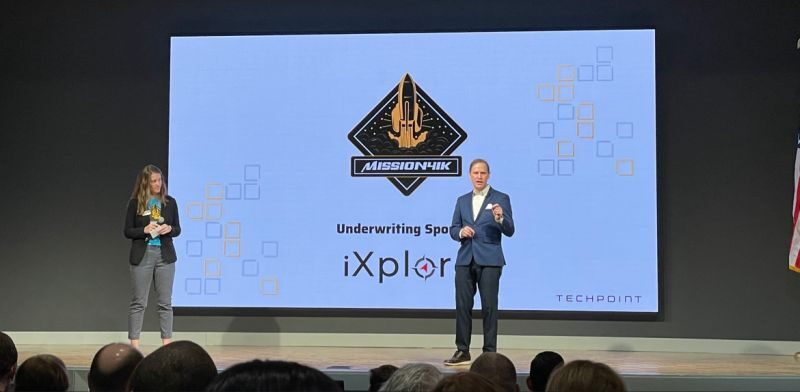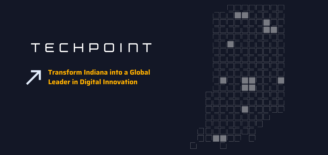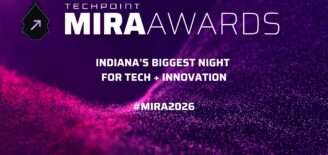2024 Mission 41K Impact Network Summit Outlines New Strategies for Statewide Education and Workforce Improvements
About 200 representatives from Indiana tech employers, community organizations, educational institutions, and the public sector met last week for the 2024 Mission41K Impact Network Summit to continue refining the collaborative effort to grow the state tech workforce.
To reach M41K goals, the state must add 41,000 net new tech workers (plus 14,000 to replace those exiting the workplace, or 56,000 new tech workers overall) within its seven-year timeframe. Getting there will require collaborators to improve education in Indiana’s schools, encourage children to gain the skills necessary for Digital Age careers, retain young adults with tech skills and academic credentials, upskill adults and help more employers evolve hiring processes.
“Mission41K began in 2022 with the Indiana tech community coming together to collaborate on a common goal of inclusively growing the tech workforce. We then created a platform through MetaImpact for our many partners to collaborate and share,” said TechPoint’s Senior Vice President of Talent, Strategy and Partnerships Dennis Trinkle, PhD.
“Now,” he continued, “We are creating specific metrics to get to our 2030 goals. We’ll continue to add new partners who will help us keep growing, rounding out what we need to achieve and the pathways to get there. We’re excited at the momentum and confident we’ll reach out goals.”
Trinkle used the M41K Summit backdrop to announce a new statewide talent strategy, which will enable the adoption of a clear, integrated system of support for Indiana’s talent and workforce from kindergarten and throughout lifelong learning. The systematic approach was developed with help from the TechPoint Foundation for Youth and Nextech, organizations Trinkle called fellow “architects of a statewide STEM talent strategy.
Nextech supports Computer Science education and consider it to be foundational for success in the Information Age. The TechPoint Foundation for Youth is widely known for its State Robotics Initiative and other experiential programs that encourage Indiana’s elementary and high school students to study STEM and consider careers in the field.
Trinkle said the M41K partners will cultivate an interconnected and inclusive STEM talent ecosystem for Indiana that spans early childhood education through adult learners and reskillers. That structure will provide every Hoosier who wants it with access to education level-appropriate programming, equitable opportunity and the resources and support they need to excel in the dynamic world of digital innovation.
“Nextech and TechPoint and others are doing great work in this area,” Trinkle said. “We’re calling the Mission 41K work a collaborative ‘impact network.’ Even if they excelled in STEM subjects, by the time most kids reach 8th grade, most have misconceptions about advanced industries where they could use that knowledge, if they think of them at all. With tech, they think coding is the only type of tech job. We have to tell the story, do it early and connect it to real life work examples so it inspires them.”
Trinkle said that important work doesn’t stop in the classrooms or with after school programs. “We need a continuous network of exposure. And, just as importantly, we need to eradicate barriers that are in these kids’ ways.”
With regard to adult and lifelong learning, the Summit focused on presentations from Indiana Commissioner for Higher Education Chris Lowery and Sagamore Institue President Theresa Lubbers. Their success is necessary to prepare Hoosiers to meet Mission41K goals.
Lubbers spoke about Workforce 2024 Pathways to Prosperity, a collaborative effort of leaders like the Central Indiana Corporate Partnership, Elevate Ventures, the Governor’s Workforce Cabinet, the Indiana Chamber of Commerce, InVested, the Lumina Foundation, OneAmerica Financial, Sagamore Institute, Strada Education Foundation, TechPoint and others.
The initiative will co-create and synthesize the analysis and recommendations of experts in the future of work, workforce and learning in Indiana. It will also engage civic leaders across the state with issues in an evolving and ongoing collaborative process that incorporates feedback and pioneers solutions, she said.
Lowery outlined state education plans for Indiana to rank nationally in the top 10 states by 2030:
- Post-high school training and education going-rates for youth and adults across all demographics
- Post-secondary degree attainment for veterans and individuals with disabilities
- Utilization of credit for prior learning,
- The rate at which Hoosiers successfully complete their chosen area of study,
- Retaining college graduates
- Measurable distinction of social and economic mobility and prosperity, and
- Recognition for growing or starting a business based on the strength of human capital.
Indiana’s current high school-to college attendance rate is 53 percent. Its college graduation rate is 67 percent, and it ranks 36th in graduate retention. Indiana’s biggest goal is to have 60 percent of its residents earn a college degree or post-high school credential by the year 2025, an increase of about 4 percent.
In addition to the presentations, the Summit featured breakout sessions focused on:
- Skills-based hiring best practices,
- Upskilling opportunities through Infosys’ Springboard Digital Academy,
- Organizations helping to build an inclusive workforce like Specialisterne, which helps employers tap into the talents of a neurodiverse workforce, and BDPA, which works to enable the upward mobility of African Americans and other minorities in the Information Technology (IT) and STEM fields.
- How to access career scholarships using a new state law that provides funding to upskill post-high school students with Career Scholarship Accounts they can use to acquire certifications and career coaching, and
- How to use the MetaImpact platform to collaborate on M41K initiatives.
Trinkle said he was pleased with the high energy of Summit attendees and saw it as an embodiment of the momentum building to improve Indiana’s educational and workforce systems.
“We’re really revving up the engines,” he said.




